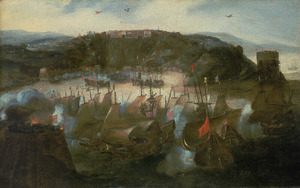Capture of Bahia facts for kids
Quick facts for kids Capture of Salvador |
|||||||
|---|---|---|---|---|---|---|---|
| Part of the Dutch-Portuguese War | |||||||
 Attack on San Salvador (c. 1624), oil painting by Andries van Eertvelt (1590–1652) |
|||||||
|
|||||||
| Belligerents | |||||||
| Commanders and leaders | |||||||
|
Mendonça Furtado | ||||||
| Strength | |||||||
| 6,500 | 3,000 | ||||||
| Casualties and losses | |||||||
| 50 killed or wounded | Unknown | ||||||
The Capture of Salvador was an important battle in 1624. It happened between Portugal (which was then joined with Spain) and the Dutch West India Company. The battle ended with the Dutch taking control of the city of Salvador in what is now Brazil. This capture was part of a big Dutch plan called the Groot Desseyn. Even though Spain knew about the Dutch plans, they did not stop them.
Contents
Planning the Attack on Salvador
On December 22, 1623, a large Dutch fleet set sail from Texel. It was led by Admiral Jacob Willekens and Vice Admiral Pieter Heyn. The fleet had 35 ships and carried 6,500 soldiers. After a storm, they arrived at Cape Verde. There, Willekens told everyone their secret goal: to capture Salvador.
Why Salvador Was Important
The Dutch wanted to take Salvador for a few reasons. They planned to use its port as a trading base. This would help them with their trade routes to the East Indies. Also, Salvador was a major center for sugar production. By controlling it, the Dutch hoped to control much of the sugar trade in the area.
Preparing Salvador's Defenses
The Portuguese governor of Salvador was Diogo de Mendonça Furtado. He quickly gathered about 3,000 men to defend the city. Most of these were local Portuguese people and black slaves. They were not happy with Spanish rule. The city's port was protected by the sea and two forts: Fort Santo António and Fort São Filipe. They also set up a six-gun battery on the beach and blocked the streets with barricades.
The Capture of Salvador
On May 8, the Dutch fleet arrived near Salvador. They split into two groups. One group sailed towards Santo António beach. Soldiers led by Colonel Johan van Dorth landed there. The other group anchored near the town. They started firing at the coastal defenses. These defenses were quickly destroyed.
The City Falls Quickly
By dawn, more than 1,000 Dutch soldiers had surrounded the city. They had two cannons with them. The Portuguese defenders became scared. Many of them threw down their weapons and ran away. This left Governor Mendonça with only 60 loyal soldiers. Salvador was captured very quickly. The Dutch only lost about 50 soldiers who were killed or wounded.
Dutch Leaders Move On
After the capture, Willekens and Heyn left Colonel Dorth in charge of Salvador. They then went on to new missions as they had been ordered. Four ships were sent back to Holland. They carried valuable goods and the news of the victory. They also carried instructions to ask for more soldiers to help keep Salvador safe.
After the Capture
However, the Dutch soldiers in Salvador soon faced problems. Local fighters, led by Bishop Dom Marcos Teixeira, began to attack them. The Bishop had escaped inland and gathered a force of 1,400 Portuguese and 250 Indian helpers.
Guerrilla Attacks Begin
These local fighters built strongholds and set up ambushes in the forests. They often attacked the Dutch soldiers. Colonel Dorth himself was killed while trying to push back the attackers from the edge of the city. This made the Dutch soldiers feel discouraged.
New Commanders Face Challenges
Albert Schoutens took over from Dorth. But he also died in another ambush. His brother, Willem, then became the commander. The Portuguese would return the next year and take back the city.

